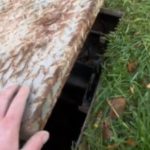A dozen nine-year-olds sit cross-legged on a red and blue mat on the floor of a classroom at a UNRWA school in Khan Younis. It’s the first week of school, and the space is dark: A chalkboard has been put up over the windows at the front of the class, the only place there was room for it. Sheets of white tarp cover the walls, hiding burns and other markings of the ongoing war.
There’s no bell to mark the start and end of class, no chairs or desks. The students, desperate for any semblance of a routine from before the war, use whatever papers they can find and a pencil to write down the day’s lesson — today, it’s Arabic grammar, and the use of “this” and “that.”
“The students are scared to come,” Israa Wadi, 30, who is teaching the class, told CBC freelance videographer Mohamed El Saife. “But we do a relaxation period in the beginning of every course for five to 10 minutes.”
As the Israel-Hamas war approaches the one-year mark, UNRWA, the UN agency for Palestinians, worked with the Gaza Ministry of Education to implement a back-to-school program this year. But many of these spaces still hold the remnants of the war.
“These classrooms are not appropriate … at all for teaching students, but we try as best as we can to run lessons,” Muhammad Al-Nawajha, UNRWA educational district officer, told El Saife. “The [back-to-school] project is spread across most cities in the Gaza Strip.”
Classrooms not fit for teaching
Starting in August, UNRWA administrators identified 94 spaces in schools that could serve as learning areas. It’s since opened 36 in Khan Younis, for about 7,600 kids sheltering in their facilities, said Sam Rose, senior director of UNRWA affairs in Gaza. Though some of them were always classrooms, like Wadi’s, others included storage closets and offices.
In Wadi’s classroom, the personal belongings of the families sheltering there are still lined up against the wall. Each day, they leave before students file in at 8 a.m. Their mattresses, laundry baskets, pots and pans are all pushed aside, making room for the 10 children, whose daily lessons involve Arabic, English, math and science.
It’s back to school for some children in Gaza thanks to a program run by the UN Palestinian refugee agency UNRWA, which has opened classrooms in shelters that were once schools. But Israa Wadi, a teacher there, says it’s difficult to teach in a place where children can still feel the scars of the war.
“The physical environment is not made for learning at all, we need notebooks for the students,” Wadi said. “[We need] a clean classroom, or at least a classroom without the remnants of destruction or war.”
The kids say they’re just excited to be learning again — it’s the normalcy they’ve longed for over the last few months. One student, Ranim Al-Qan, tells El Saife that she studies and, in between lessons, plays, to feel better.
“When the war came, it destroyed us and destroyed our ambitions,” Al-Qan told El Saife. “We started searching for water, and we stopped studying.”
Parents are wary of the back-to-school season, too, said Rose. While they’re excited for their kids to learn, he said, they’re also fearful of not having them in their line of sight.
“They’re generally scared all the time because this stuff could happen at any time,” he said. “But in general, I think they kind of just accept it.”
Minimizing harm on ‘sensitive sites’: IDF
In a statement to CBC, the Israel Defence Forces said it was “attacking military targets to dismantle Hamas’s military capabilities” and said “significant efforts” have been made to evacuate civilians to safe zones, including “100,000 calls made, 9.3 million leaflets dropped, 15.5 text messages sent and 17 million voice recordings delivered.”
In the statement, the IDF said the challenge of keeping civilians safe is made more difficult because Hamas “deliberately positions its operations within civilian areas.” It added that Israel makes efforts to “ensure all strikes comply with international legal obligations, including proportionality.”
The IDF said it remains in contact with international organizations, and works to identify “sensitive sites to minimize harm.” It also maintains “ongoing validation of these sensitive sites, alongside assessments of their status and occupancy.”
Finally, the statement noted the establishment of a board focused on “co-ordinating planned humanitarian activities” and ensuring the safety of workers. It stated that daily meetings were held between all organizations and IDF representatives to “discuss planned activities” and “review plans for continued humanitarian actions.”
Gaza children finished just 6 weeks of school
Rose said that out of the 183 buildings that housed UNRWA schools across the strip, at least 121 have sustained strikes from the war. (The total could be higher, as security constraints prevent UNRWA from completely assessing the total damage.)
Before the war began, the Gaza Strip held around 560 school buildings in total, according to the United Nations, serving over 625,000 students.
According to the UN’s report, as of mid-February, the majority of school buildings that had been directly hit were in areas that the Israeli military had designated for evacuation.
This week, two airstrikes on an UNRWA school in central Gaza killed six staff members. The agency said it was the fifth time the school had been attacked since the war began.
In a post on X, Philippe Lazzarini, commissioner general of UNRWA, said that the organization closed “all its schools” and turned them into shelters when the war started.
“Mattresses have replaced school desks. Too many schools are no place for learning. They have become places of despair, hunger, disease and death.”
Over the last year, children in Gaza had completed only “six weeks” of the 38-week school year, according to a June 2024 UNRWA briefing note.
“Children are not safe nor are they protected. UNICEF estimates that all of Gaza’s 1.2 million children need mental health and psychosocial support,” the brief said.
The Israel-Hamas war began after a Hamas-led attack on southern Israel on Oct.7 killed 1,200 people and saw 250 hostages taken into Gaza, according to Israeli figures. Israel’s responding incursion into the strip has killed over 41,000, according to the Gaza Health Ministry.
Happy to be back to learning
Despite her current classroom being a stark difference from her previous one,
Al-Qan, the student, says she’s grateful to be back to school, “remembering what we learned, little by little.”
Another student, Asmahan Ashour, eagerly recites her lesson after Wadi.
Then, hunched over a piece of paper on the floor, she scribbles notes from the board, looking up quickly to make sure she’s got it right.
“The class is dark and burnt, and our backs hurt when we write,” Ashour tells El Saife after her lesson.
“I forgot the letters…. In math, I forgot multiplications … in English, I forgot the new words we had learned.”
Al-Qan says she enjoys being able to meet her friends in class rather than on the road, getting water for her family or at the market.
“We’re very happy we started learning again.”












